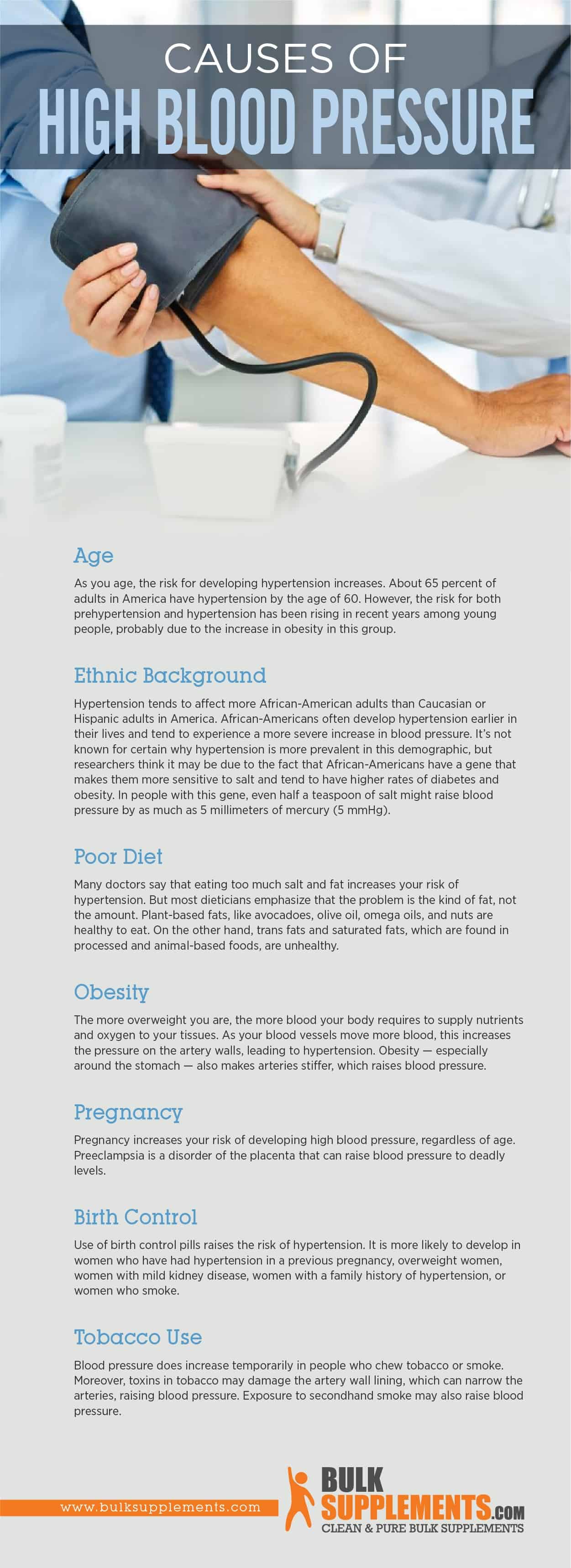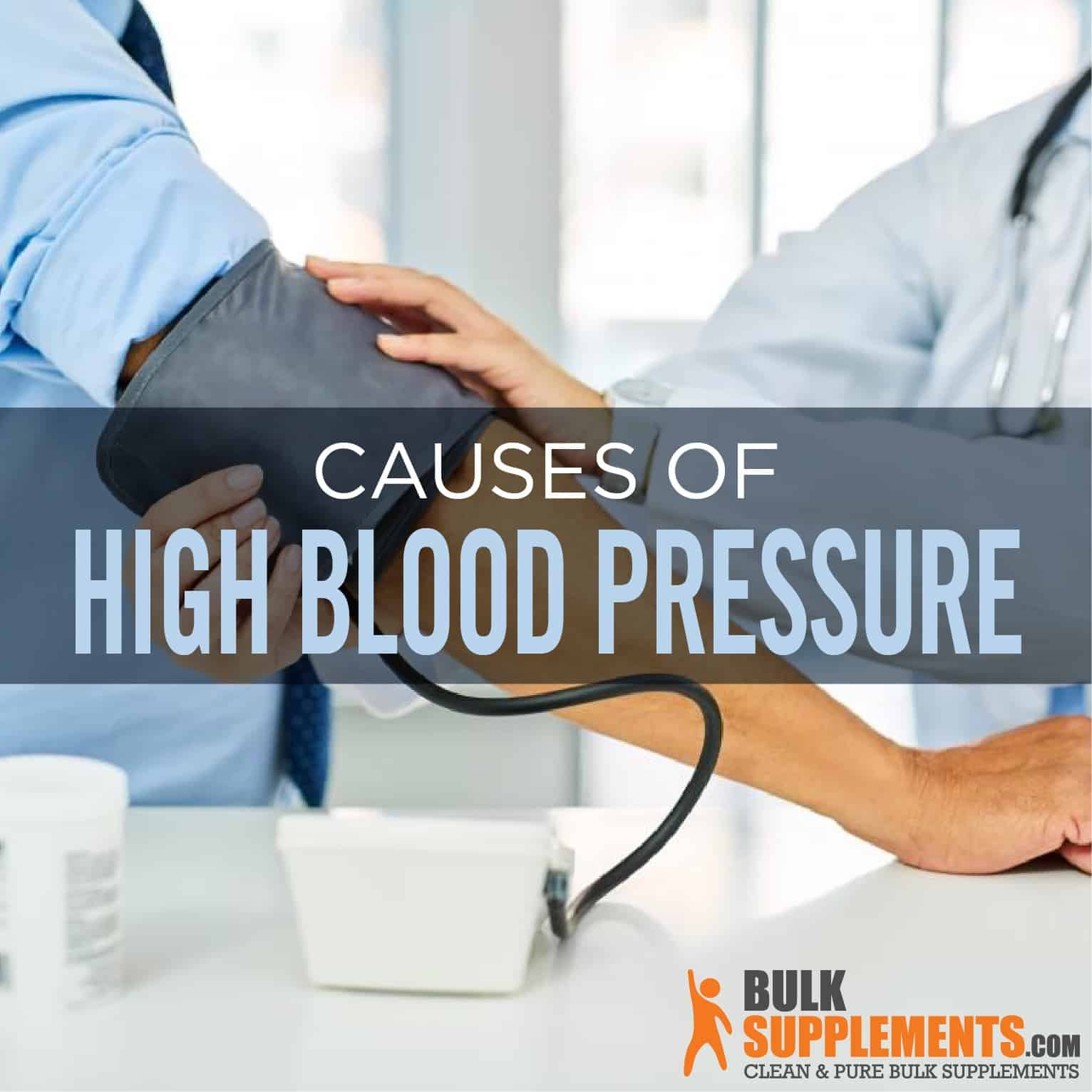What is High Blood Pressure?
Over 100 million Americans suffer from high blood pressure (or hypertension). That’s almost half of American adults (x). Hypertension often causes no symptoms you can feel or see, but it is very common among older adults and is a serious health issue (x).
Blood pressure refers to the force of blood as it flows along the arteries in the body. Arteries carry blood from the heart to the rest of the body. With each heartbeat, blood is pushed through your arteries. While the blood moves, pressure is put on the artery walls in what is known as blood pressure.
Hypertension occurs when blood moves at a pressure that’s higher than normal. A variety of things can increase blood pressure. If you have abnormally high blood pressure, or it remains high for a long period of time, you may suffer serious health problems. Extreme cases of hypertension can increase one’s risk for heart disease, heart attack, stroke and kidney failure.
Forms of High Blood Pressure:
Primary Hypertension
Also known as essential hypertension, primary hypertension is the most common form of hypertension. It’s called primary hypertension when there’s no obvious cause for it. Primary hypertension usually takes several years to occur. It’s probably a result of one’s lifestyle, environment and body changes due to aging.
Secondary Hypertension
This develops when a medicine or health problem causes your hypertension. Things that may bring on secondary hypertension include kidney issues, sleep apnea, certain medicines and adrenal or thyroid gland problems.
Symptoms of High Blood Pressure
Most individuals with hypertension won’t have any symptoms. It’s for this reason that hypertension is often called “the silent killer”.
Hypertensive Crisis
When blood pressure reaches around 180/120 mm Hg (normal blood pressure is between 120/80 and 140/90), it turns into a medical emergency called a hypertensive crisis. At this stage, there may be symptoms like:
- Headache
- Vomiting
- Nausea
- Dizziness
- Nosebleeds
- Blurred vision
- Breathlessness
- Heart palpitations
If you have these symptoms, seek medical attention.
High Blood Pressure in Children
In children, the following symptoms may indicate high blood pressure:
- Nosebleeds
- Headache
- Blurred vision
- Fatigue
- Bell’s palsy
Very young babies and newborns with hypertension may have these symptoms:
- Irritability
- Seizures
- Respiratory distress
- Lethargy
People with a hypertension diagnosis should get regular blood pressure readings. If your blood pressure is within the usual range, you should have a reading once every five years. Anyone with certain risk factors should have more regular checks.
Causes of High Blood Pressure
Age
As you age, the risk for developing hypertension increases. About 65 percent of adults in America have hypertension by the age of 60 (x). However, the risk for both pre-hypertension and hypertension has been rising in recent years among young people, probably due to the increase in obesity in this group (x).
Ethnic Background
Hypertension tends to affect more African-American adults than Caucasian or Hispanic adults in America. African-Americans often develop hypertension earlier in their lives and tend to experience a more severe increase in blood pressure (x). It’s not known for certain why hypertension is more prevalent in this demographic, but researchers think it may be due to the fact that African-Americans have a gene that makes them more sensitive to salt and tend to have higher rates of diabetes and obesity. In people with this gene, even half a teaspoon of salt might raise blood pressure by as much as 5 millimeters of mercury (5 mmHg) (x).
Poor Diet
Many doctors say that eating too much salt and fat increases your risk of hypertension. But most dieticians emphasize that the problem is the kind of fat, not the amount. Plant-based fats, like avocados, olive oil, omega oils, and nuts are healthy to eat. On the other hand, trans fats and saturated fats, which are found in processed and animal-based foods, are unhealthy.
Obesity
The more overweight you are, the more blood your body requires to supply nutrients and oxygen to your tissues. As your blood vessels move more blood, this increases the pressure on the artery walls, leading to hypertension. Obesity — especially around the stomach — also makes arteries stiffer, which raises blood pressure (x).
Pregnancy
Pregnancy increases your risk of developing high blood pressure, regardless of age. Preeclampsia is a disorder of the placenta that can raise blood pressure to deadly levels.
Birth Control
Use of birth control pills raises the risk of hypertension. It is more likely to develop in women who have had hypertension in a previous pregnancy, overweight women, women with mild kidney disease, women with a family history of hypertension, or women who smoke (x).
Tobacco Use
Blood pressure does increase temporarily in people who chew tobacco or smoke. Moreover, toxins in tobacco may damage the artery wall lining, which can narrow the arteries, raising blood pressure. Exposure to secondhand smoke may also raise blood pressure (x).

Treatment for High Blood Pressure
Most people with hypertension will need treatment for life to help delay or prevent serious health issues caused by the condition. Treatment usually aims to reach and keep blood pressure under 130/80 mmHg (x). Treatment options for hypertension can include taking medication and eating healthy with less salt, as well as making some lifestyle changes.
Diet
Eating a healthy diet and limiting your sodium intake is a vital part of treating it. It’s recommended that you consume less than 2,300 milligrams of sodium a day (x). If you have hypertension, you may need to consume even less sodium. You should consume not more than 1,500 milligrams a day, according to the American Heart Association (x).
It’s important to look at food labels carefully and choose low-sodium, “no salt added” options while cooking and at the convenience store. You doctor can recommend the DASH diet, which focuses on whole grains, vegetables, and fruits, as well as low-fat or fat-free dairy products, poultry, fish, nuts, vegetables, and beans. The DASH diet also restricts foods rich in saturated fats, such as full-fat dairy products, tropical oils like palm and coconut oil, and sugary beverages and other sweets (x). A 2017 study found that abiding by the DASH diet and a low-salt diet was as helpful as some drugs in reducing systolic blood pressure (x).
Exercise
Regular workouts can help you control your weight, as well as reduce your blood pressure. The America Heart Association suggests about 40 minutes of moderate or vigorous aerobic activity 3-4 times per week to decrease blood pressure (x).
Don’t Smoke
While smoking is a known risk factor to heart disease and stroke, its association with hypertension is yet to be understood. Both smoking and exposure to secondhand smoke raises the risk of atherosclerosis, which is accelerated by hypertension. Smoking also triggers a temporary rise in blood pressure (x). Get tips on how to quit smoking from your doctor, and research medication and devices to help you quit smoking.
Supplements for High Blood Pressure
There are several supplements that are effective, safe and affordable when it comes to controlling hypertension:
Potassium Gluconate Powder
This supplement supports heart health, muscle function and healthy bones. Take 435 milligrams of potassium gluconate powder once per day.
Beet Root Powder
Beet root powder is rich in antioxidants and supports overall health. Take 3,500-7,000 milligrams of beet root powder daily, or as recommended by your physician.
Potassium Citrate Powder
This supplement is a combination of potassium and citric acid. It’s often the ideal potassium source for those who need supplementation. Take exactly 275 milligrams of potassium citrate powder once a day.
L-Citrulline Powder
This supplement promotes overall athletic performance. It’s especially helpful for people involved in endurance workouts or any form of intense exercise. Take 3,000 milligrams of L-citrulline twice a day.
Pumpkin Seed Extract
Pumpkin seeds are rich in nutrients and fiber, as well as essential fatty acids and antioxidants. They may promote heart, urinary tract, and immune health. Take 550 milligrams of pumpkin seed extract daily, or as recommended by your physician.
Living with High Blood Pressure
Managing your hypertension is a lifelong obligation. You’ll always need to make healthy food decisions, monitor your weight, exercise, avoid smoking, learn to deal with stress and cut down on alcohol. You’ll likely need medication to manage your blood pressure for life.
Also, you’ll have to get used to frequent blood pressure checks. You may be required to see your doctor regularly. Or you might be asked to monitor your blood pressure on your own and keep an eye on the figures for your doctor.
The Bottom Line
Approximately one third of American adults have hypertension (hypertension), which equates to around 75 million people (x). Blood pressure refers to the level of force your blood exerts on artery walls as it flows along arteries. When this pressure shoots up, it may lead to severe health conditions, including hypertension.
Most people with hypertension show no symptoms. For this reason, it is sometimes referred to as “the silent killer”. It’s vitally important to get blood pressure checks regularly.
Some people experience nosebleeds, shortness of breath, or headaches with hypertension. But those symptoms may mimic various other things, serious or not. Often, these symptoms occur when blood pressure reaches a seriously high level over time.
Certain factors raise one’s risk of developing blood pressure, including a family history of hypertension, age, ethnic background, poor diet, being overweight or obese, lack of physical activity, alcohol intake, smoking and stress.
Most people with hypertension will need lifetime treatment to help prevent or delay serious medical conditions caused by hypertension. Treatment options for hypertension can include taking medication and eating healthy with less salt, and making some lifestyle changes.


